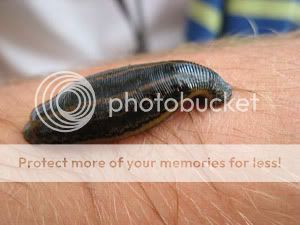Phylum Annelida Quiz: The Segmented Worms!

Phylum Annelida: The Segmented Worms. Zoology Lab.
Questions and Answers
- 1.
The phylum Annelida is made up of .....
- A.
Pseudocoelomates
- B.
Aceolomates
- C.
Eucoelomates
Correct Answer
C. EucoelomatesExplanation
Annelida is a phylum that includes segmented worms. These worms have a true coelom, which is a fluid-filled body cavity completely lined with mesoderm. This makes them eucoelomates. Pseudocoelomates have a body cavity that is only partially lined with mesoderm, while aceolomates lack a body cavity altogether. Therefore, the correct answer is eucoelomates.Rate this question:
-
- 2.
What are the repeating body segments called?
Correct Answer
MetameresExplanation
Metameres are the repeating body segments found in certain organisms. These segments are similar in structure and function, and they often repeat along the length of the body. This repetition allows for specialization and efficiency in different body regions. Examples of organisms with metameres include annelid worms and arthropods. These segmented body plans provide flexibility and adaptability, allowing the organisms to perform a variety of different movements and functions.Rate this question:
- 3.
In the phylum Annelida, their digestive system is complete.
- A.
True
- B.
False
Correct Answer
A. TrueExplanation
Annelids belong to the phylum Annelida, which includes segmented worms like earthworms and leeches. These organisms have a complete digestive system, which means that they have a mouth for ingestion, a specialized tube-like structure for digestion and absorption of nutrients, and an anus for the elimination of waste. This allows them to efficiently process and extract nutrients from their food. Therefore, the statement that the digestive system of Annelida is complete is true.Rate this question:
-
- 4.
A crop in the phylum Annelida is used for...
- A.
Temporary Storage
- B.
Movement
- C.
Grinding
Correct Answer
A. Temporary StorageExplanation
The crop in the phylum Annelida is used for temporary storage. The crop is a specialized organ found in some annelids, such as earthworms, and it serves as a storage chamber for food. It allows the annelid to store excess food temporarily before it is further digested and absorbed. This adaptation is particularly useful for annelids that consume large quantities of food at once or for those that have irregular feeding patterns. The crop helps ensure a steady supply of nutrients for the annelid, allowing it to survive periods of food scarcity.Rate this question:
-
- 5.
The gizzard in the phylum Annelida is used for.....
- A.
Temporary Storage
- B.
Nothing
- C.
Grinding
Correct Answer
C. GrindingExplanation
The gizzard in the phylum Annelida is used for grinding. Annelida is a phylum that includes segmented worms, and the gizzard is a muscular organ found in their digestive system. It helps break down food particles by grinding them into smaller pieces, aiding in the digestion process. This allows the worms to extract nutrients more efficiently from their food.Rate this question:
-
- 6.
The genus Nereis is found in what class?
Correct Answer
PolychaetaExplanation
The genus Nereis is found in the class Polychaeta. Polychaeta is a class of marine worms that are characterized by their numerous bristle-like appendages called chaetae. Nereis is a genus within this class, which means that it belongs to the group of marine worms with chaetae.Rate this question:
- 7.
The genus Lumbricus is found in what class?
Correct Answer
OligochaetaExplanation
The genus Lumbricus is found in the class Oligochaeta. Oligochaeta is a class of annelids that includes earthworms, and Lumbricus is a genus of earthworms. Therefore, it can be inferred that Lumbricus belongs to the class Oligochaeta.Rate this question:
- 8.
The genus Hirudo is found in what class?
Correct Answer
HirudineaExplanation
The genus Hirudo belongs to the class Hirudinea.Rate this question:
- 9.
Genus Lumbricus is found in what phylum?
Correct Answer
AnnelidaExplanation
Genus Lumbricus belongs to the phylum Annelida. Annelida is a phylum that includes segmented worms, such as earthworms. The characteristics of this phylum include a segmented body, a well-developed coelom, and a closed circulatory system. Genus Lumbricus specifically refers to the earthworms, which are part of the Annelida phylum.Rate this question:
- 10.
What genus is this species?
Correct Answer
HirudoExplanation
This species belongs to the genus Hirudo.Rate this question:
- 11.
What genus is this species?
Correct Answer
LumbricusExplanation
The given species is named Lumbricus, which also happens to be the genus name. In taxonomy, the genus is a rank below family and above species. It is a way to categorize and group similar species together. Therefore, the correct answer is Lumbricus, as it is both the species name and the genus name in this case.Rate this question:
- 12.
What genus is this species?
Correct Answer
NereisExplanation
The given species is named Nereis, which is also the genus of the species. In taxonomy, the genus is a rank in the classification system that groups closely related species together. Therefore, the correct answer is Nereis because the species belongs to the same genus.Rate this question:
Quiz Review Timeline +
Our quizzes are rigorously reviewed, monitored and continuously updated by our expert board to maintain accuracy, relevance, and timeliness.
-
Current Version
-
Mar 13, 2023Quiz Edited by
ProProfs Editorial Team -
Mar 11, 2011Quiz Created by
Caellic
- Amphibian Quizzes
- Bird Quizzes
- Cat Quizzes
- Dinosaur Quizzes
- Dog Quizzes
- Emperor Penguin Quizzes
- Endangered Species Quizzes
- Fish Quizzes
- Goat Quizzes
- Hamster Quizzes
- Horse Quizzes
- Insect Quizzes
- Invertebrate Quizzes
- Mammal Quizzes
- Mouse Quizzes
- Nematode Quizzes
- Pet Quizzes
- Pig Quizzes
- Rabbit Quizzes
- Reptile Quizzes
- Sheep Quizzes
- Wolf Quizzes
- Zoo Quizzes
 Back to top
Back to top





